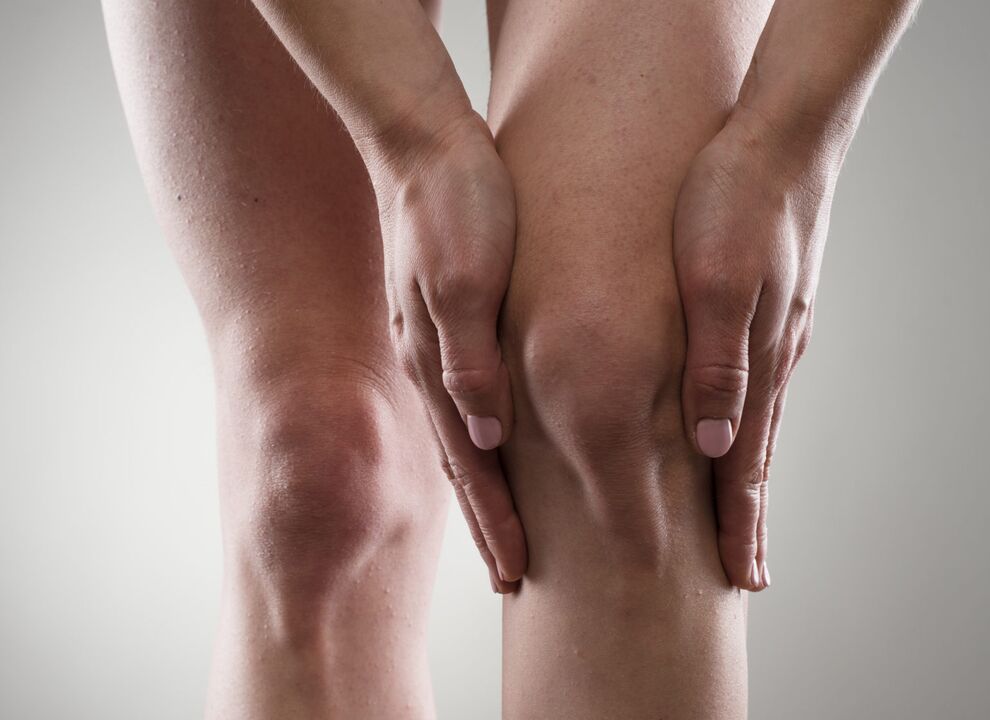
Arthrosis of the knee joint (deforming osteoarthritis of the knee joint, DOA, gonarthrosis) is called degenerative-dystrophic changes in the articular structures, in which the cartilaginous layer between the bone elements first becomes thinner and then collapses. In the initial stages, the patient feels discomfort and slight limitation of mobility, then the joint becomes deformed and, as the cartilage is destroyed, it completely loses its functions. Acute osteoarthritis is very painful and is accompanied by a significant decrease in the patient's physical activity. If treatment of knee joint gonarthrosis is not started on time, the patient may remain disabled.
For reference:According to statistics, one in five adults in the world suffers from osteoarthritis in the knee joint. Knee osteoarthritis can be unilateral or bilateral; in women, the pathology is diagnosed twice as often as in men. People over 45 years of age often face the problem of joint deformation due to age-related changes in the body. If this diagnosis is made in young people, the cause is usually trauma.
Why does pathology develop?
The knee joint is one of the most complex in the human body. It bears most of the load when walking and other movements. It is not surprising that with age its elements begin to wear out and lose their functions. First, the cartilage layer in the articular joint loses elasticity and elasticity, then dries up and cracks. The shock-absorbing properties of cartilage are reduced, and this is precisely what causes discomfort and pain when moving: the shocks and impacts of the joint structures against each other are no longer alleviated by anything, the bones gradually become exposed and rub against each other.
Deforming arthrosis of the knee joint in old age is an optional phenomenon and is not diagnosed in all people. There are several provoking factors, the combination of which causes pathological changes in the joint.
The most common causes of pathology are the following:
- excess weight – the joint has to support additional loads;
- Osteoporosis is a pathology in which bone tissue demineralization occurs;
- chronic diseases associated with metabolic disorders in the body;
- traumatic sports - gonarthrosis is often called football players' disease due to frequent trauma to the knee joint;
- some types of professional activities associated with intense physical activity - arthrosis and osteoarthritis - are found in porters;
- spinal injuries, in which the distribution of loads on the joints of the lower extremities is disturbed;
- hereditary predisposition.
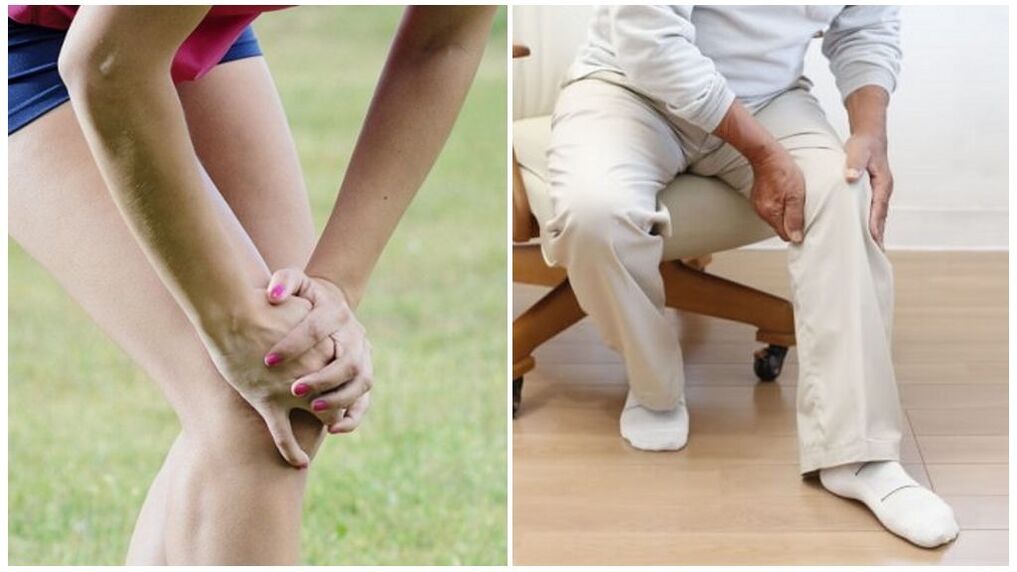
Articular cartilage does not wear out immediately. In the initial stages, the manifestations of the disease are absent or insignificant, the patient does not consult a doctor and does not take any measures to stop the pathological process. But, if dystrophic changes are still identified, the patient has time to start treatment and prevent irreversible changes. To do this, you must first establish what the main signs of osteoarthritis of the knee joints are.
How to recognize the disease
The symptoms of osteoarthritis of the knee joint become pronounced at the stage when the cartilage has already become thinner and has begun to deteriorate. Grade 1 gonarthrosis can take years to manifest. However, later, attentive patients remember that they still felt atypical symptoms, they simply did not attach much importance to them, as they were not constant and did not cause much discomfort.

You can suspect destruction and inflammation of the right or left knee joint based on the following specific signs:
- morning stiffness in joints;
- limitation of mobility after a long stay in the same position;
- knee discomfort when climbing stairs - burning sensation, hypersensitivity;
- nighttime pain in the knees;
- pain after physical work or sports;
- periodic sudden weakening of the lower extremities. If right-sided gonarthrosis or left-sided gonarthrosis occurs, only one affected leg will give way.
Even so, the main symptom of knee joint destruction remains pain. They can vary in intensity and sometimes decrease. But as the pathologies progress, they appear more frequently, become more intense and bother the patient even at rest, in the absence of physical activity. Based on the severity of the symptoms, the doctor can diagnose the stage of the disease.
- Manifestations of stage 1 pathology:pain is not yet a concern, the patient may notice rapid fatigue when playing sports or physical activities, a slight limitation of joint mobility after prolonged rest. An x-ray will show a slight narrowing of the space between the bones of the joint, an uneven surface of the cartilage with slight impactions.
- For 2 degree gonarthrosissymptoms appear brighter and more frequently. The patient usually already understands that something is wrong with their knees. Joints hurt and "twist" when the weather changes, after physical exertion. Even the gentlest movements result in knee pain. If a person rests his legs, the pain will disappear. But under load they will resume again. Also at this stage of the pathology, there may be a characteristic clicking sound in the knee when bending and extending the leg, difficulty and pain when trying to bend the leg at the knee more than 90 degrees. An x-ray will show a change in the shape of the joint cup and the presence of fluid in the joint cavity.
- Gonarthrosis 3 degreescharacterized by intense pain that occurs regardless of whether the limb is loaded or at rest. The painful joint is especially painful at night and when weather conditions change. The patient can no longer bend his leg at the knee, which is why his physical activity and performance decrease. The x-ray clearly shows degenerative changes in the joint tissues. The deformation is also visually noticeable to the naked eye. The patient's legs are bent at the knees like the letter "o" or "x", which ultimately leads to the inability to move independently, without support, and even more so to carry out usual professional and domestic tasks. The person becomes incapacitated.

Typically, patients consult a doctor in the second stage of the disease, mainly to find an effective medication for knee pain. In the first stage, it is quite difficult to identify gonarthrosis, as the symptoms are mild and only small changes are visible on x-rays. It is only possible to detect pathological changes in the joint with a thorough examination.
Diagnostic methods
Diagnosis begins with a visual examination and questioning of the patient. What will indicate the possible development of gonarthrosis:
- increase and change in the shape of the knee joint;
- a distinct crunch when the kneecap is dislocated;
- pain when palpating the joint;
- limitation of joint mobility.
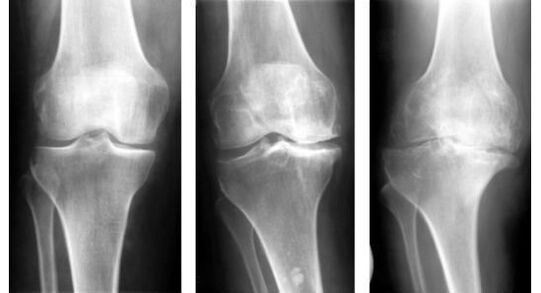
In the early stages, degenerative changes in cartilaginous tissue may not be visible; for this reason, computed tomography and magnetic resonance imaging are additionally recommended. With the help of modern diagnostic techniques, the doctor can accurately determine the severity of the joint damage, whether there is inflammation and accumulation of fluid in the joint cavity, as well as differentiate osteoarthritis of the knee joint from other pathologies.
Classification
In modern orthopedics, there are two main types of osteoarthritis of the knee joints:
- primary gonarthrosis;
- secondary gonarthrosis.
The primary form of the disease develops alone due to age-related changes or metabolic disorders. Secondary is a consequence of another illness, injury or unsuccessful surgical intervention. Post-traumatic osteoarthritis of the knee joint can develop several months after a bruise, subluxation, or fracture. According to the nature of the course, osteoarthritis is classified as acute or chronic. It is easier to cure the acute form of the disease.
Official remedy for gonarthrosis
Complex treatment of osteoarthritis of the knee joint begins only after the final confirmation of the diagnosis. If the patient's condition is not critical, doctors will first try to stop the progression of the pathology with the help of medications. Physiotherapy, massage and manual therapy are used as additional methods.
The main goals of complex therapy:
- relieve pain and discomfort;
- restore joint mobility;
- stop the destruction of the cartilaginous layer and, if possible, restore it.
Important points are physiotherapy and adherence to a special diet. There are exercises and products that restore damaged joint tissues and help restore mobility, at least partially. If you consult a doctor in a timely manner, these measures will be enough for the knee joint to fully function again.
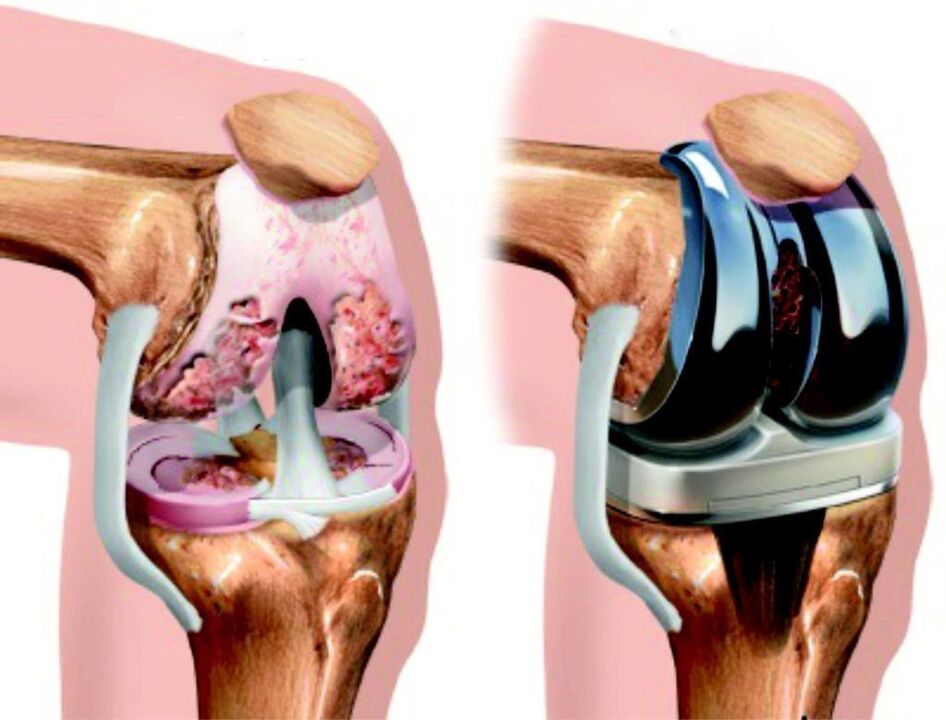
But if the disease has reached the third stage, the joint is seriously damaged, even the most expensive medicines will not help restore it. Surgery will be necessary to preserve at least partial function of the limb. It consists of removing the remains of the affected joint structures and implanting an implant, a procedure called endoprosthesis.
Drug treatment of gonarthrosis
To eliminate the unpleasant symptoms of the disease, restore and strengthen the joint, a complex of drugs of various groups and actions is used.
- Nonsteroidal anti-inflammatory drugs- with them, joint treatment begins, they quickly relieve pain, swelling, fever and partially stop the inflammatory process. But they cannot be taken for a long time, since the active components in the composition have an extremely negative effect on the functions of the digestive tract and the composition of the blood. Typically, the course of NSAID treatment lasts no more than 5-7 days. Medications can be in the form of tablets for internal use or in the form of ointments and gels for external use.
- Chondroprotectors– are medicines that improve the nutrition of cartilaginous tissue and restore its firmness and elasticity. Chondroprotectors also partially relieve pain and swelling. But these drugs don't work immediately. The first effect will be noticeable a few weeks after starting treatment. It is recommended to take chondroprotectors for at least six months.
- Hormonal drugs.They are also called corticosteroids. Medicines containing hormones are used if the pain is very severe and the inflammation progresses even after a period of NSAID use. They are administered as injections intramuscularly or directly into the joint cavity. These medications instantly relieve pain, reduce swelling and inflammation. But they have a number of contraindications and even more side effects than non-steroidal anti-inflammatory drugs, so they are prescribed in extreme cases. Hormonal medicines can only be purchased in pharmacies with a prescription. Immediately after the patient's condition improves, corticosteroids are discontinued.
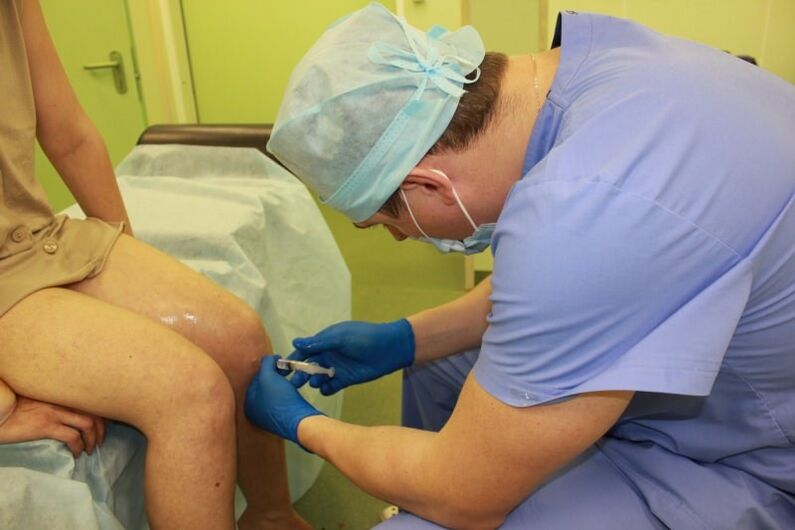
The treatment is complemented with intra-articular injections of hyaluronic acid. This substance stimulates the production of synovial fluid, saturates cells with moisture, restores their elasticity, firmness and prevents abrasions. The cost of the procedure is quite high, but the effectiveness is worth the cost.
On a note:Of all the drugs listed above, only chondroprotectors affect the cause of the disease. They stimulate the regeneration of destroyed cartilage tissue and prevent damage to surviving cartilage cells. But these drugs are expensive, and to obtain a noticeable and lasting effect, they must be taken regularly for several months in a row, and sometimes even years. The cost of complete treatment for many patients, especially retired ones, is often prohibitive.
Unconventional treatment methods
Patients who have experienced firsthand what knee arthrosis is and what unpleasant symptoms it manifests, always have several remedies available in stock, in case the pharmacy and medicines are not available. People suffering from gonarthrosis and knee pain prepare tinctures, rubs and ointments based on medicinal plants in advance - almost all recipes require time and fresh raw materials, available only in spring-summer.
Dandelion treatment
There are several ways to strengthen the joint and restore its mobility, as well as get rid of unbearable pain with the help of this medicinal plant. The simplest thing is to eat five dandelion heads every day during the flowering period. This should be done on an empty stomach, after rinsing the flowers with boiled water. A tincture for rubbing joints is also prepared from dandelions.
The cooking recipe is as follows:
- Collect exactly 50 open dandelion heads.
- Place in a dark glass jar with a tight lid.
- Pour 300 ml of good vodka or triple cologne.
- Infuse away from sunlight for a month, shaking the container from time to time.
- Without extracting, transfer to the first aid kit, use before bed to rub the sore knee, then wrap the joint with heat and go to bed under a blanket.
There is another interesting recipe against joint osteoarthritis using dandelion. First you need to collect the leaves of the plant and dry them. Then pour boiling water and let it steam for half an hour. The resulting mixture must be chewed slowly and carefully for the time necessary to take exactly 3 thousand steps.
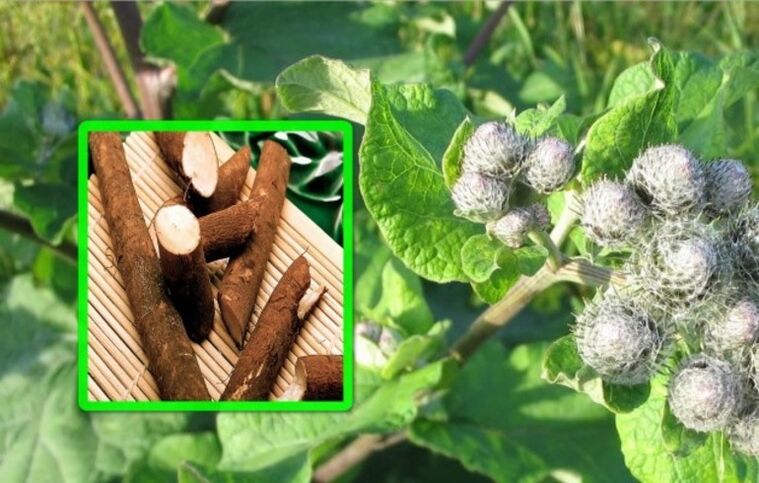
Recipes with burdock
The simplest recipe:
- choose two or three new leaves from the plant and rinse with cold water;
- Lightly crush the leaves to release the juice;
- Apply to the affected joint and secure with a bandage.
Keep this "compress" overnight, remove it in the morning and throw away the leaves. Repeat the procedure daily for three weeks.
To enhance the effect, traditional healers advise lubricating the knee with cinquefoil oil before applying burdock. It is very easy to prepare. Two tablespoons of chopped cinquefoil are placed in 250 ml of any purified vegetable oil without fragrances. The oil must be well preheated, but not boiling. Leave the mixture for two weeks, then the oil can be used to treat joints.
Turpentine, eggs and other joint remedies
Using the yolk of a chicken egg, you can prepare an effective massage for joint pain. It is prepared like this:
- Lightly beat an egg yolk in a bowl.
- Add a small spoonful of turpentine and stir.
- Then add a large spoonful of vinegar and beat again.
The mixture is stored in the refrigerator and used before bed. After rubbing, the knee is wrapped in a warm cloth overnight. In the morning, you need to remove the bandage and rinse off the remaining product with warm water, and then apply any antiarthrosis ointment.
Remember that all homemade preparations only take effect immediately after preparation, they are not stored for a long time (with the exception of alcohol tinctures, they can be stored in a dark, cool place for up to six months). Don't expect instant results. Folk remedies act cumulatively: lasting relief will only occur after three to four weeks of regular use of home remedies for knee osteoarthritis. In the later stages, they will not be effective and will only help to temporarily reduce pain and swelling.
Summary:Osteoarthritis of the knee joint, or gonarthrosis, is one of the most common injuries of the musculoskeletal system in the elderly. In young people it occurs after injury or during excessive physical exertion. The disease can be completely cured only at stages 1-2 with a competent and comprehensive approach. In the third phase, it is most often necessary to resort to endoprosthesis to restore, at least partially, the functions of the limb and prevent complications.

























